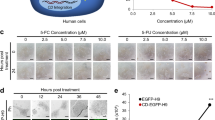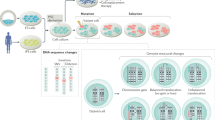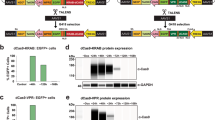Abstract
Many applications in human pluripotent stem cell (PSC) research require the genetic modification of PSCs to express a transgene in a stable and dependable manner. Random transgene integration commonly results in unpredictable and heterogeneous expression. We describe a protocol for the derivation of clonal populations of human embryonic stem cells or induced pluripotent stem cells (iPSCs) expressing a transgene from a single copy of an integrated lentiviral vector that is mapped to the genome. Using optimized transduction conditions, followed by single-cell subcloning and a round of antibiotic selection, we find that approximately half of the colonies retrieved contain a single vector copy. After expansion, the majority of these are confirmed to be clonal. The vector/genomic DNA junction is sequenced and the unique integration site is mapped to the genome. This protocol enables the efficient derivation of genetically modified PSCs containing an integrated transgene at a known genomic site in ∼7 weeks.
This is a preview of subscription content, access via your institution
Access options
Subscribe to this journal
Receive 12 print issues and online access
$259.00 per year
only $21.58 per issue
Buy this article
- Purchase on Springer Link
- Instant access to full article PDF
Prices may be subject to local taxes which are calculated during checkout









Similar content being viewed by others
References
Thomson, J.A. et al. Embryonic stem cell lines derived from human blastocysts. Science 282, 1145–1147 (1998).
Takahashi, K. et al. Induction of pluripotent stem cells from adult human fibroblasts by defined factors. Cell 131, 861–872 (2007).
Hamaguchi, I. et al. Lentivirus vector gene expression during ES cell-derived hematopoietic development in vitro. J. Virol. 74, 10778–10784 (2000).
Gropp, M. et al. Stable genetic modification of human embryonic stem cells by lentiviral vectors. Mol. Ther. 7, 281–287 (2003).
Ma, Y., Ramezani, A., Lewis, R., Hawley, R.G. & Thomson, J.A. High-level sustained transgene expression in human embryonic stem cells using lentiviral vectors. Stem Cells 21, 111–117 (2003).
Xiong, C. et al. Genetic engineering of human embryonic stem cells with lentiviral vectors. Stem Cells Dev. 14, 367–377 (2005).
Ellis, J. Silencing and variegation of gammaretrovirus and lentivirus vectors. Hum. Gene. Ther. 16, 1241–1246 (2005).
Cherry, S.R., Biniszkiewicz, D., van Parijs, L., Baltimore, D. & Jaenisch, R. Retroviral expression in embryonic stem cells and hematopoietic stem cells. Mol. Cell Biol. 20, 7419–7426 (2000).
Wu, X., Li, Y., Crise, B. & Burgess, S.M. Transcription start regions in the human genome are favored targets for MLV integration. Science 300, 1749–1751 (2003).
Schroder, A.R. et al. HIV-1 integration in the human genome favors active genes and local hotspots. Cell 110, 521–529 (2002).
King, W., Patel, M.D., Lobel, L.I., Goff, S.P. & Nguyen-Huu, M.C. Insertion mutagenesis of embryonal carcinoma cells by retroviruses. Science 228, 554–558 (1985).
Li, Z. et al. Murine leukemia induced by retroviral gene marking. Science 296, 497 (2002).
Kustikova, O. et al. Clonal dominance of hematopoietic stem cells triggered by retroviral gene marking. Science 308, 1171–1174 (2005).
Kohn, D.B., Sadelain, M. & Glorioso, J.C. Occurrence of leukaemia following gene therapy of X-linked SCID. Nat. Rev. Cancer 3, 477–488 (2003).
Papapetrou, E.P. et al. Genomic safe harbors permit high beta-globin transgene expression in thalassemia induced pluripotent stem cells. Nat. Biotechnol. 29, 73–78 (2011).
Lavon, N., Yanuka, O. & Benvenisty, N. The effect of overexpression of Pdx1 and Foxa2 on the differentiation of human embryonic stem cells into pancreatic cells. Stem Cells 24, 1923–1930 (2006).
Wang, L. et al. Generation of hematopoietic repopulating cells from human embryonic stem cells independent of ectopic HOXB4 expression. J. Exp. Med. 201, 1603–1614 (2005).
Gropp, M. & Reubinoff, B.E. Lentiviral-RNA-interference system mediating homogenous and monitored level of gene silencing in human embryonic stem cells. Cloning Stem Cells 9, 339–345 (2007).
Huber, I. et al. Identification and selection of cardiomyocytes during human embryonic stem cell differentiation. FASEB J. 21, 2551–2563 (2007).
Placantonakis, D.G. et al. BAC transgenesis in human embryonic stem cells as a novel tool to define the human neural lineage. Stem Cells 27, 521–532 (2009).
Lavon, N., Yanuka, O. & Benvenisty, N. Differentiation and isolation of hepatic-like cells from human embryonic stem cells. Differentiation 72, 230–238 (2004).
Singh Roy, N. et al. Enhancer-specified GFP-based FACS purification of human spinal motor neurons from embryonic stem cells. Exp. Neurol. 196, 224–234 (2005).
Eiges, R. et al. Establishment of human embryonic stem cell-transfected clones carrying a marker for undifferentiated cells. Curr. Biol. 11, 514–518 (2001).
Niwa, H., Miyazaki, J. & Smith, A.G. Quantitative expression of Oct-3/4 defines differentiation, dedifferentiation or self-renewal of ES cells. Nat. Genet. 24, 372–376 (2000).
Williams, D.A. & Thrasher, A.J. Out of harm's way. Nat. Biotechnol. 29, 41–42 (2011).
Giudice, A. & Trounson, A. Genetic modification of human embryonic stem cells for derivation of target cells. Cell Stem Cell 2, 422–433 (2008).
Costa, M. et al. A method for genetic modification of human embryonic stem cells using electroporation. Nat. Protoc. 2, 792–796 (2007).
Lakshmipathy, U. et al. Efficient transfection of embryonic and adult stem cells. Stem Cells 22, 531–543 (2004).
Siemen, H. et al. Nucleofection of human embryonic stem cells. Stem Cells Dev. 14, 378–383 (2005).
Gerrard, L., Zhao, D., Clark, A.J. & Cui, W. Stably transfected human embryonic stem cell clones express OCT4-specific green fluorescent protein and maintain self-renewal and pluripotency. Stem Cells 23, 124–133 (2005).
Tomishima, M.J., Hadjantonakis, A.K., Gong, S. & Studer, L. Production of green fluorescent protein transgenic embryonic stem cells using the GENSAT bacterial artificial chromosome library. Stem Cells 25, 39–45 (2007).
Zwaka, T.P. & Thomson, J.A. Homologous recombination in human embryonic stem cells. Nat. Biotechnol. 21, 319–321 (2003).
Irion, S. et al. Identification and targeting of the ROSA26 locus in human embryonic stem cells. Nat. Biotechnol. 25, 1477–1482 (2007).
Davis, R.P. et al. Targeting a GFP reporter gene to the MIXL1 locus of human embryonic stem cells identifies human primitive streak-like cells and enables isolation of primitive hematopoietic precursors. Blood 111, 1876–1884 (2008).
Urbach, A., Schuldiner, M. & Benvenisty, N. Modeling for Lesch-Nyhan disease by gene targeting in human embryonic stem cells. Stem Cells 22, 635–641 (2004).
Lombardo, A. et al. Gene editing in human stem cells using zinc finger nucleases and integrase-defective lentiviral vector delivery. Nat. Biotechnol. 25, 1298–1306 (2007).
Zou, J. et al. Gene targeting of a disease-related gene in human induced pluripotent stem and embryonic stem cells. Cell Stem Cell 5, 97–110 (2009).
Hockemeyer, D. et al. Efficient targeting of expressed and silent genes in human ESCs and iPSCs using zinc-finger nucleases. Nat. Biotechnol. 27, 851–857 (2009).
Song, H., Chung, S.K. & Xu, Y. Modeling disease in human ESCs using an efficient BAC-based homologous recombination system. Cell Stem Cell 6, 80–89 (2010).
Suzuki, K. et al. Highly efficient transient gene expression and gene targeting in primate embryonic stem cells with helper-dependent adenoviral vectors. Proc. Natl. Acad. Sci. USA 105, 13781–13786 (2008).
Khan, I.F. et al. Engineering of human pluripotent stem cells by AAV-mediated gene targeting. Mol. Ther. 18, 1192–1199 (2010).
Kustikova, O.S. et al. Dose finding with retroviral vectors: correlation of retroviral vector copy numbers in single cells with gene transfer efficiency in a cell population. Blood 102, 3934–3937 (2003).
Watanabe, K. et al. A ROCK inhibitor permits survival of dissociated human embryonic stem cells. Nat. Biotechnol. 25, 681–686 (2007).
Acknowledgements
This work was supported by the Starr Foundation (Tri-Institutional Stem Cell Initiative, Tri-SCI-018); by New York State Stem Cell Science, NYSTEM (N08T-060); and by the National Heart, Blood and Lung Institute, NHLBI grant HL053750. We thank members of the Sadelain, Riviere, Studer and Tomishima laboratories (Memorial Sloan-Kettering Cancer Center, New York) for helpful discussions and technical assistance.
Author information
Authors and Affiliations
Contributions
E.P.P. developed the protocol and wrote the paper. M.S. supervised the study and edited the paper.
Corresponding author
Ethics declarations
Competing interests
The authors declare no competing financial interests.
Rights and permissions
About this article
Cite this article
Papapetrou, E., Sadelain, M. Derivation of genetically modified human pluripotent stem cells with integrated transgenes at unique mapped genomic sites. Nat Protoc 6, 1274–1289 (2011). https://doi.org/10.1038/nprot.2011.362
Published:
Issue Date:
DOI: https://doi.org/10.1038/nprot.2011.362
This article is cited by
-
Gut-like ectodermal tissue in a sea anemone challenges germ layer homology
Nature Ecology & Evolution (2017)
-
Therapeutic activity of modified U1 core spliceosomal particles
Nature Communications (2016)
-
LiPS-A3S, a human genomic site for robust expression of inserted transgenes
Molecular Therapy - Nucleic Acids (2016)
-
Somatic Correction of Junctional Epidermolysis Bullosa by a Highly Recombinogenic AAV Variant
Molecular Therapy (2014)
Comments
By submitting a comment you agree to abide by our Terms and Community Guidelines. If you find something abusive or that does not comply with our terms or guidelines please flag it as inappropriate.



